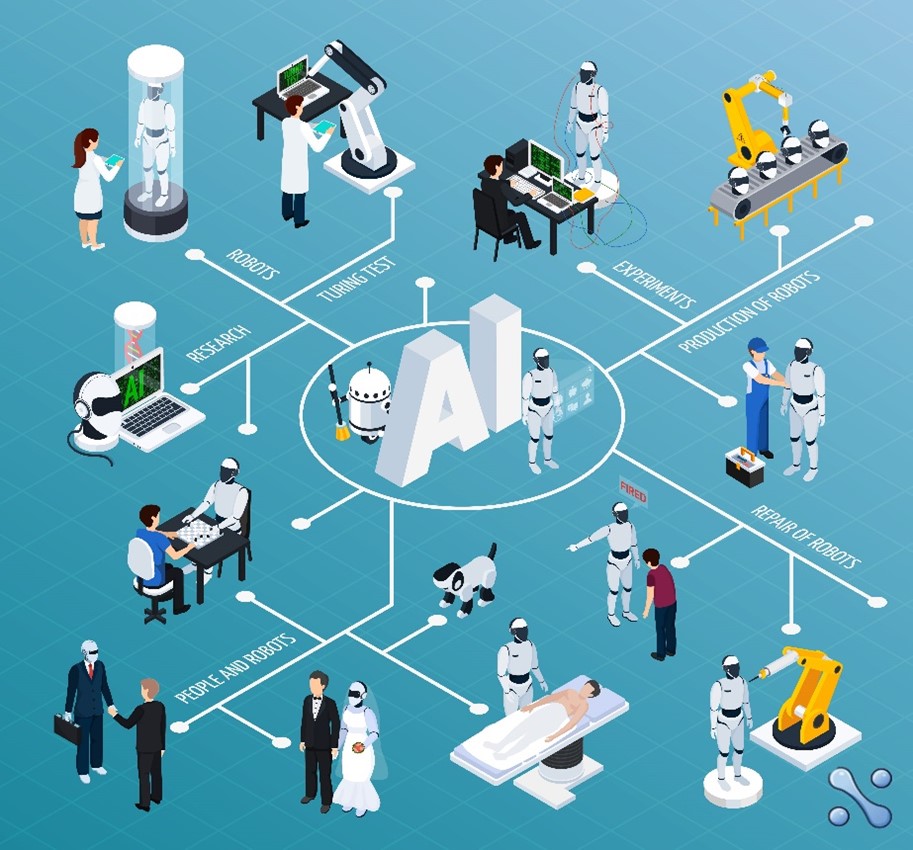Artificial intelligence has rapidly evolved from a concept of science fiction into one of the most transformative forces, capable of doing extraordinary things limited only by our imagination. From powering predictive analytics to producing personalized customer experiences – AI’s disruptive potential is immense.
The numbers suggest a similar pattern as Global AI market size is forecasted to reach a mind numbing $1800 billion by 2030 at a staggering CAGR of 37.3%.
This incredible opportunity means enterprises must urgently master the art of intelligently building, deploying and scaling AI models. But where does one start? Before we delve deeper into the question of how to make an AI model, let’s first understand its basics.
AI/ML 101: Grasping the Fundamentals
At its core, an AI model is an algorithm trained on vast datasets to perform predictive tasks, surface insights or exhibit intelligent behavior. Machine learning techniques like deep neural networks and supervised learning underpin most modern AI by enabling systems to learn from data without explicit programming.
AI encompasses a constellation of technologies including machine learning, computer vision, natural language processing (NLP), robotics and beyond. However, before applying these powerful capabilities, organizations must first grasp foundational concepts and terminology to formulate an effective AI strategy. Upskilling cross-functional teams on AI fundamentals leads in the right direction towards maximizing its value creatively.

The Model Development Lifecycle
While AI development approaches may vary, most intelligent model lifecycles involve distinct phases:
- Data sourcing, cleaning and preprocessing
- Exploratory analysis identifying patterns
- Feature extraction and engineering
- Selecting appropriate ML algorithms
- Training models on curated data
- Evaluating, fine-tuning model performance
- Deployment with monitoring processes
This cross-functional endeavour demands a seamless bridging of software engineering rigor with advanced statistical methods.
Data quality issues alone account for up to 85% of AI projects failing. Overlooking any aspect jeopardizes model robustness, making meticulous planning across the entire workflow a crucial aspect.
How to make an AI model requires thoughtfully mapping dependencies based on desired goals. Teams must collaboratively streamline processes like data pipeline creation, feature selection strategies, model evaluation criteria, deployment monitoring and more. An interdisciplinary union of talents spanning data engineering, machine learning expertise and domain context is indispensable.
Where AI Shines: Innovative Use Cases
AI unlocks immense potential to positively transform business across sectors.
At least 63% organizations leverage AI to enhance supply chains and manufacturing quality.
From anticipating production defects through sensor data to optimizing logistics networks – the applications are myriad.
The real transformative force is cloud-based development pipelines. Enterprises can rapidly prototype and tailor AI solutions on the cloud, significantly mitigating risks and costs. Moreover, cloud data engineering empowers organizations to consolidate disengaged data sources into unified platforms, structuring and preprocessing the data to optimize AI model performance. This centralized data management approach provides businesses with a streamlined data provisioning service tailored for AI initiatives.
The quest for developing an AI model also calls for identifying ideal opportunities in real-world scenarios. This requires careful studying of evolving market dynamics. Emerging AI breakthroughs enable novel conveniences like self-driving cars, virtual assistants for conversational interfaces, smart health condition monitoring and more. Maintaining a pulse on shifting customer needs orients AI interventions towards maximum relevance.
Architecting AI at Scale

While AI promises remarkable possibilities, leveraging its full potential requires meticulous upfront architectural planning. Designing robust, interoperable data pipelines is critical for aggregating diverse data sources into centralized, AI-ready data lakes and warehouses.
However, only 26.5% of firms have developed cohesive data strategies for AI and analytics transformation initiatives.
Failure to address AI’s architectural requirements from inception leads to long-term challenges like inconsistent model versioning, operational decay and technical debt.
A well-designed, future-proof AI architecture balances scalability and governance. It employs modular microservices and containerization to enable fluid deployment across hybrid/multi-cloud environments. Cloud vendors provide fully managed AI services and specialized hardware accelerating training/inference tasks. Meanwhile, automated MLOps platforms remove complexities, streamlining model lifecycle management at scale.
No matter the stack, upholding core principles like agility, scalability, security and monitoring is paramount. Thoughtful architectural design based on these pillars accelerates AI’s business impact while controlling technical abilities. Investing in the right AI infrastructure upfront compounds returns over time.
Unify Your Data & Unleash AI\'s Potential
Stop siloed data from holding back your AI initiatives
Get Started
Best Practices for Enterprises
Mastering AI’s end-to-end value chain requires organizational rigor and flexibility in equal measure. Investing in scalable cloud infrastructure provides the essential foundation. Upskilling talent pools while formulating overarching data strategies steadily builds AI capabilities.
Importing established DevOps principles accelerates AI development agility by staying focussed on delivery. Consistently following an iterative “start small, fail fast” approach with well-researched use cases also enhances AI’s viability within risk tolerances.
Other key best practices include:
- Building interdisciplinary teams collaborating seamlessly
- Automating workflows rigorously through MLOps tooling
- Continuous learning from AI research and case studies
- Aligning initiatives to core business strategy and KPIs
- Designing AI Ethics Boards and Responsible AI frameworks
Strategically employing these methods helps reduce the risks of AI journeys while accelerating iteration and compounding returns over time for enterprises.
Supercharge AI Productivity with Workflow Automation
Leverage MLOps tooling to streamline AI workflows, drive faster delivery
Automate Your AI Workflows
Fostering Trust Through AI Transparency
For users and partners, trusting AI critically shapes adoption outcomes. Opaque “black box” models unable to explain their reasoning create apprehensions. Earning confidence demands meticulous disclosure around data sources, decision factors, confidence levels and ethical oversight processes.
Visualizations and interfaces facilitating human-AI collaboration enhance transparency. For instance, counterfactual reasoning techniques illustrate how output predictions respond to changes in input variables.
How to make an AI model trustworthy? Beyond just interpretability, six key pillars define Trustworthy AI standards:
- Transparency in architecture, data and decisioning policies
- Prioritizing model interpretability and clear explanations
- Ensuring privacy safeguards and adversarial robustness
- Delineating accountability for AI system actions
- Enabling appropriate human oversight and control
- Demonstrating reliability, safety and ethical alignment
Upholding these principles grows increasingly vital as AI’s societal presence deepens over time. Forward thinking enterprises already embrace Trustworthy AI tenets through specialized AI Ethics Review Boards, public disclosure initiatives and democratizing AI literacy across stakeholders.
Future-Proofing AI Talent and Culture
Continuous learning is non-negotiable for staying ahead of AI’s fast paced evolution. Leaders need to help their teams learn new skills and give them chances to grow to prepare for the future. It’s important to work together well in special groups that focus on both AI technology and ethics.
Pioneering roles like AI Product Managers, ML Engineers, Conversational AI Specialists and AI Ethicists are gaining prominence. To help fine tune these roles, organizations must encourage learning by establishing internal AI academies, participate in AI conferences, hackathons and communities. As self-supervised and artificial general intelligence (AGI) models advance, maintaining an experimental, agile culture incentivizes the early mover advantage.
Preparing for AI’s intelligent tomorrow requires not just technical readiness, but fundamental cultural shifts within organizations. Developing interdisciplinary skillsets, instituting ethical AI governance, and designing human-centred processes bring together people and intelligent technologies harmoniously. This fusion maximizes AI’s transformative potential through responsible stewardship.

Conclusion: Towards an Intelligent Tomorrow
The way the AI revolution is shaping up, its phenomenal powers can bring prosperity or peril depending on our wisdom in nurturing it. Immense opportunities to augment humanity’s efforts are on the horizon, but so are the risks of creating historical biases at scale without rigorous safeguards. Mastering AI’s core tenets while focusing on using it ethically could lead to great outcomes for this new and developing technological marvel.
Like the grandest forms of art, crafting advanced intelligence demands relentless patience and care. But the scale of what’s possible – productivity leapfrogs, amplified speed of innovation, and unbelievable customer experiences – richly rewards those bold enough to walk this unfinished road responsibly.
Purposeful collaboration between technologists, business leaders, academics, ethicists and policymakers will ensure AI elevates society equitably.
At Neuronimbus, we guide enterprises in mastering the AI model lifecycle – from ethical reviews to implementation and monitoring. Our interdisciplinary team collaborates closely with your experts to build tailored AI capabilities, mapping your organization’s unique dynamics and market landscape. Reach out today to learn how we can help create an impactful AI-driven transformation.




